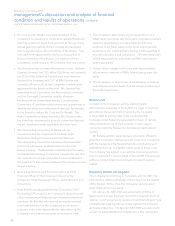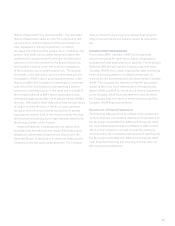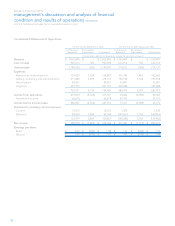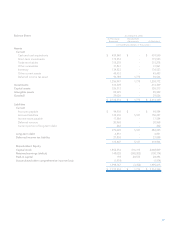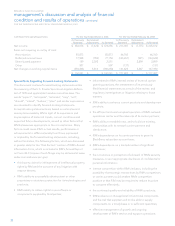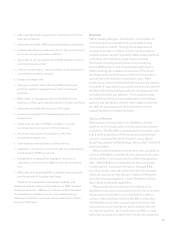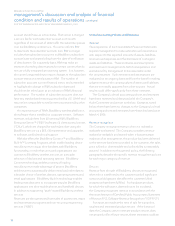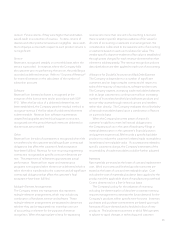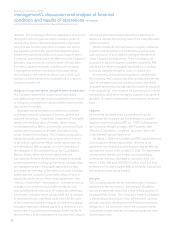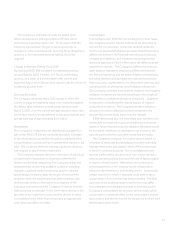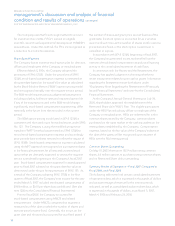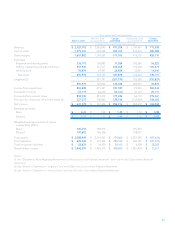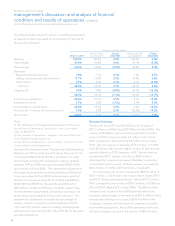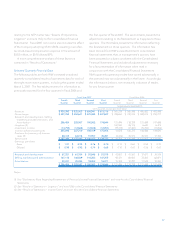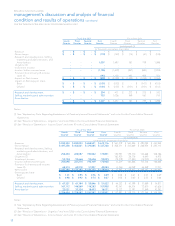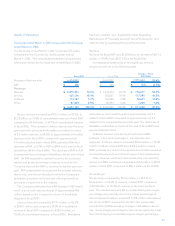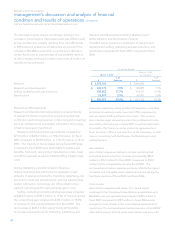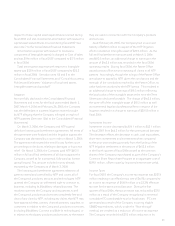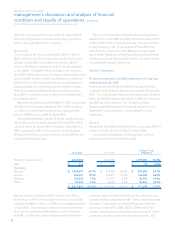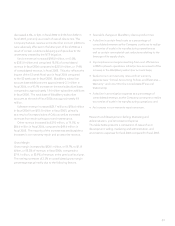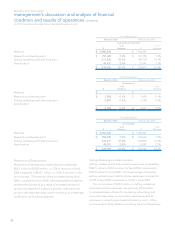Blackberry 2007 Annual Report Download - page 36
Download and view the complete annual report
Please find page 36 of the 2007 Blackberry annual report below. You can navigate through the pages in the report by either clicking on the pages listed below, or by using the keyword search tool below to find specific information within the annual report.34
RESEARCH IN MOTION LIMITED
management’s discussion and analysis of financial
condition and results of operations continued
FOR THE THREE MONTHS AND FISCAL YEAR ENDED MARCH 3, 2007
The Company uses the flow-through method to account
for investment tax credits (“ITCs”) earned on eligible
scientific research and experimental development (“SR&ED”)
expenditures. Under this method, the ITCs are recognized as
a reduction to income tax expense.
Share-Based Payment
The Company has an incentive stock option plan for directors,
officers and employees of the Company or its subsidiaries.
Effective March 5, 2006, the Company adopted the
provisions of SFAS 123(R). Under the provisions of SFAS
123(R), stock-based compensation expense is estimated at
the grant date based on the award’s fair value as calculated
by the Black-Scholes-Merton (“BSM”) option-pricing model
and is recognized rateably over the requisite service period.
The BSM model requires various judgmental assumptions
including volatility, forfeiture rates and expected option life.
If any of the assumptions used in the BSM model change
significantly, stock-based compensation expense may differ
materially in the future from that recorded in the current
period.
The BSM option-pricing model used in SFAS 123(R) is
consistent with that used in pro forma disclosures under SFAS
No. 123. The Company is using the modified prospective
transition (“MPT”) method as permitted by SFAS 123(R) to
record stock-based compensation expense and accordingly
prior periods have not been restated to reflect the impact of
SFAS 123(R). Stock-based compensation expense calculated
using the MPT approach is recognized on a prospective basis
in the financial statements for all new and unvested stock
options that are ultimately expected to vest as the requisite
service is rendered beginning in the Company’s fiscal 2007
year. Stock-based compensation expense for awards granted
prior to fiscal 2007 is based on the grant-date fair value as
determined under the pro forma provisions of SFAS 123. As
a result of the Company adopting SFAS 123(R) in the first
quarter of fiscal 2007, the Company’s net income for the year
ended March 3, 2007 included stock-based compensation of
$18.8 million, or $0.10 per share basic and diluted. (See also
note 12(b) to the Consolidated Financial Statements).
Prior to fiscal 2007, the Company accounted for
stock-based compensation using APB 25 and related
interpretations. Under APB 25, compensation expense is
measured as of the date on which the number of shares and
exercise price become fixed. Generally, this occurs on the
grant date and the award is accounted for as a fixed award. If
the number of shares and grant price are not fixed as of the
grant date, the stock option is accounted for as a variable
award until such time as the number of shares and/or exercise
prices become fixed, or the stock option is exercised, is
cancelled, or expires.
In accordance with SFAS 123(R), beginning in fiscal 2007,
the Company has presented excess tax benefits from the
exercise of stock-based compensation awards as a financing
activity in the consolidated statement of cash flows.
In connection with the Review and the Restatement, the
Company has applied judgment in choosing whether to
revise measurement dates for prior option grants. Information
regarding the Restatement is set forth above under
“Explanatory Note Regarding the Restatement of Previously
Issued Financial Statements” and note 4 to the Consolidated
Financial Statements.
At the Company’s Annual General Meeting on July 18,
2005, shareholders approved the establishment of the
Restricted Share Unit (“RSU”) Plan. The eligible participants
under the RSU Plan include any officer or employee of the
Company or its subsidiaries. RSUs are redeemed for either
common shares issued by the Company, common shares
purchased on the open market or the cash equivalent on the
vesting dates established by the Company. Compensation
expense, based on the fair value of the Company’s shares at
the date of the grant, will be recognized upon issuance of
RSUs over the RSU vesting period.
Common Shares Outstanding
On May 10, 2007, there were 185.9 million voting common
shares, 6.4 million options to purchase voting common shares
and no Restricted Share Units outstanding.
Summary Results of Operations – Fiscal 2007 Compared to
Fiscal 2006, and Fiscal 2005
The following table sets forth certain consolidated statement
of operations data, which is expressed in thousands of dollars
and as a percentage of revenue for the interim periods
indicated, as well as consolidated balance sheet data, which
is expressed in thousands of dollars, as at March 3, 2007,
March 4, 2006 and February 26, 2005:


